lock CITROEN C-ELYSÉE 2018 Handbook (in English)
[x] Cancel search | Manufacturer: CITROEN, Model Year: 2018, Model line: C-ELYSÉE, Model: CITROEN C-ELYSÉE 2018Pages: 260, PDF Size: 8.4 MB
Page 35 of 260
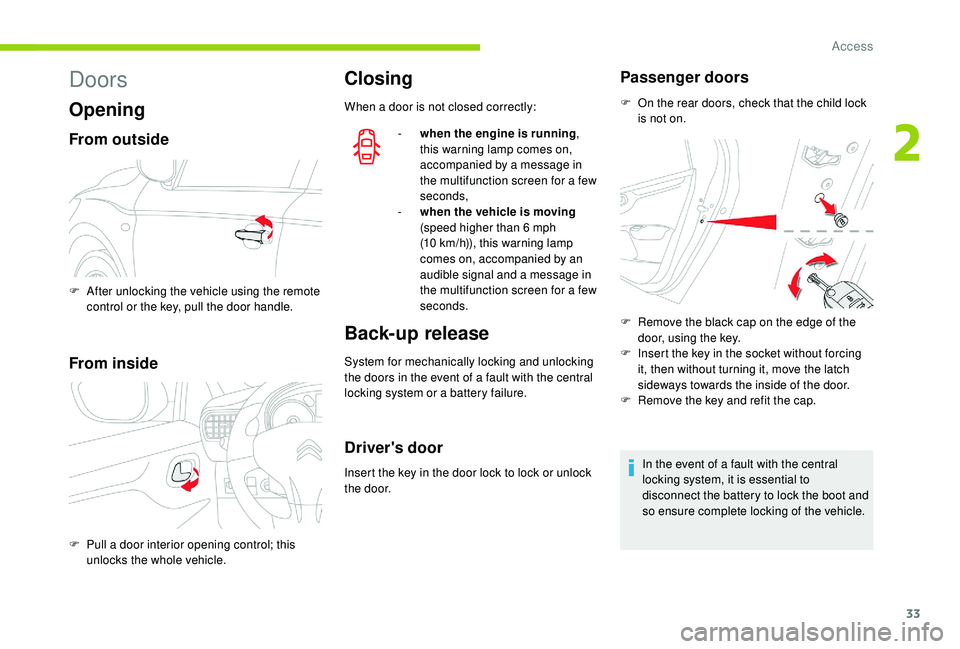
33
Doors
Opening
From outside
From inside
Closing
When a door is not closed correctly:-
w
hen the engine is running ,
this warning lamp comes on,
accompanied by a message in
the multifunction screen for a few
seconds,
-
w
hen the vehicle is moving
(speed higher than 6
mph
(10
km/h)), this warning lamp
comes on, accompanied by an
audible signal and a message in
the multifunction screen for a few
seconds.
Back-up release
System for mechanically locking and unlocking
the doors in the event of a fault with the central
locking system or a battery failure.
Driver's door
Insert the key in the door lock to lock or unlock
the door.
Passenger doors
F On the rear doors, check that the child lock is not on.
F
A
fter unlocking the vehicle using the remote
control or the key, pull the door handle.
F
P
ull a door interior opening control; this
unlocks the whole vehicle. F
R
emove the black cap on the edge of the
door, using the key.
F
I
nsert the key in the socket without forcing
it, then without turning it, move the latch
sideways towards the inside of the door.
F
R
emove the key and refit the cap.
In the event of a fault with the central
locking system, it is essential to
disconnect the battery to lock the boot and
so ensure complete locking of the vehicle.
2
Access
Page 36 of 260
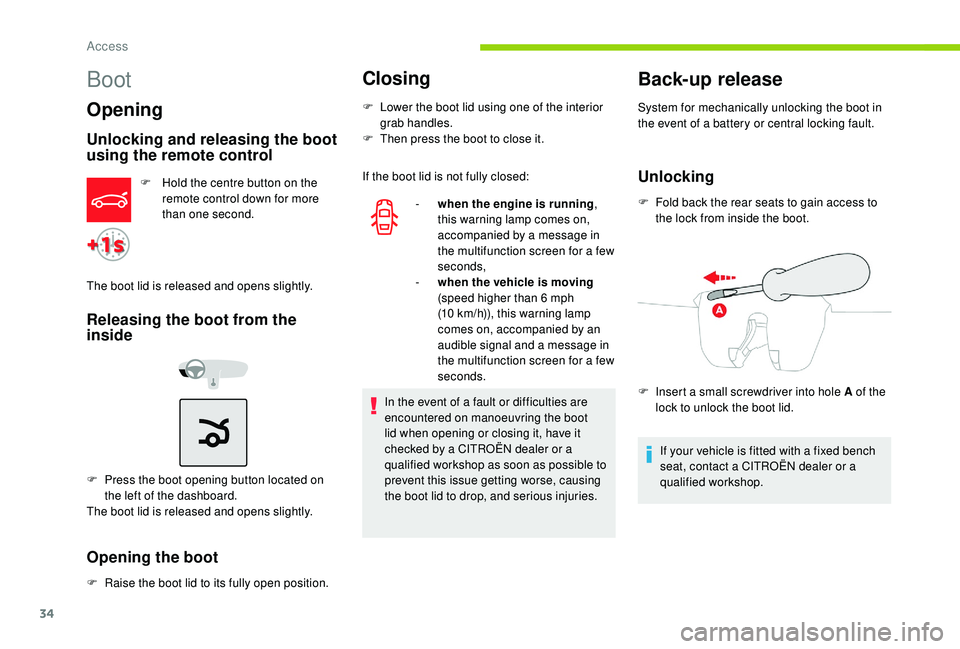
34
Boot
Opening
Unlocking and releasing the boot
using the remote control
F Hold the centre button on the remote control down for more
than one second.
The boot lid is released and opens slightly.
Releasing the boot from the
inside
F Press the boot opening button located on the left of the dashboard.
The boot lid is released and opens slightly.
Opening the boot
F Raise the boot lid to its fully open position.
Closing
F Lower the boot lid using one of the interior grab handles.
F
T
hen press the boot to close it.
-
w
hen the engine is running ,
this warning lamp comes on,
accompanied by a message in
the multifunction screen for a few
seconds,
-
w
hen the vehicle is moving
(speed higher than 6
mph
(10
km/h)), this warning lamp
comes on, accompanied by an
audible signal and a message in
the multifunction screen for a few
seconds.
Back-up release
System for mechanically unlocking the boot in
the event of a battery or central locking fault.
UnlockingIf the boot lid is not fully closed:
F
F
old back the rear seats to gain access to
the lock from inside the boot.
If your vehicle is fitted with a fixed bench
seat, contact a CITROËN dealer or a
qualified workshop.
F
I
nsert a small screwdriver into hole A of the
lock to unlock the boot lid.
In the event of a fault or difficulties are
encountered on manoeuvring the boot
lid when opening or closing it, have it
checked by a CITROËN dealer or a
qualified workshop as soon as possible to
prevent this issue getting worse, causing
the boot lid to drop, and serious injuries.
Access
Page 37 of 260
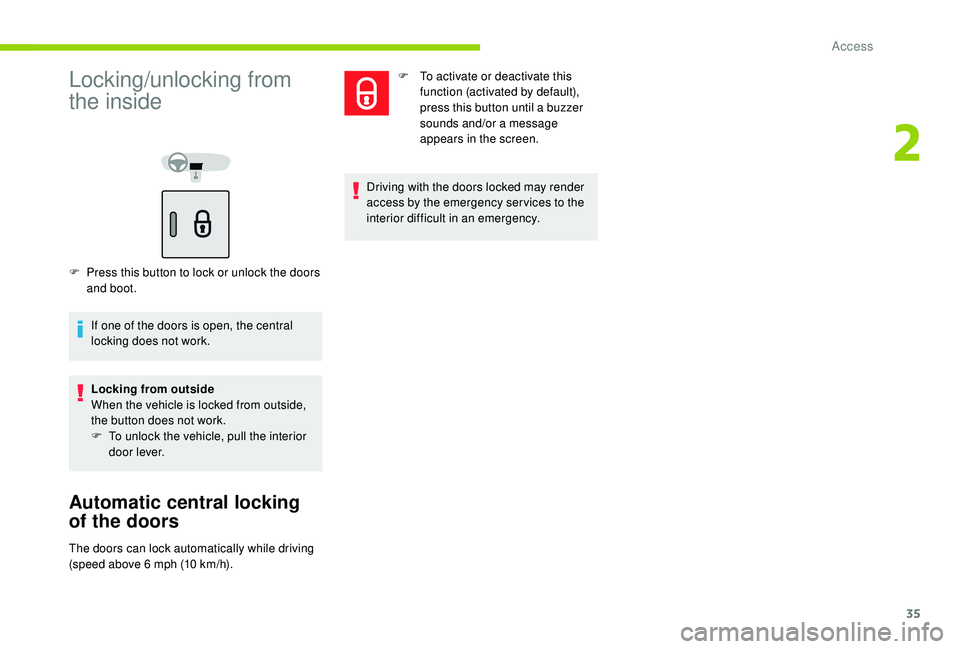
35
Locking/unlocking from
the inside
F Press this button to lock or unlock the doors and boot.
If one of the doors is open, the central
locking does not work.
Locking from outside
When the vehicle is locked from outside,
the button does not work.
F
T
o unlock the vehicle, pull the interior
door lever.
Automatic central locking
of the doors
F To activate or deactivate this function (activated by default),
press this button until a buzzer
sounds and/or a message
appears in the screen.
Driving with the doors locked may render
access by the emergency services to the
interior difficult in an emergency.
The doors can lock automatically while driving
(speed above 6
mph (10 km/h).
2
Access
Page 42 of 260
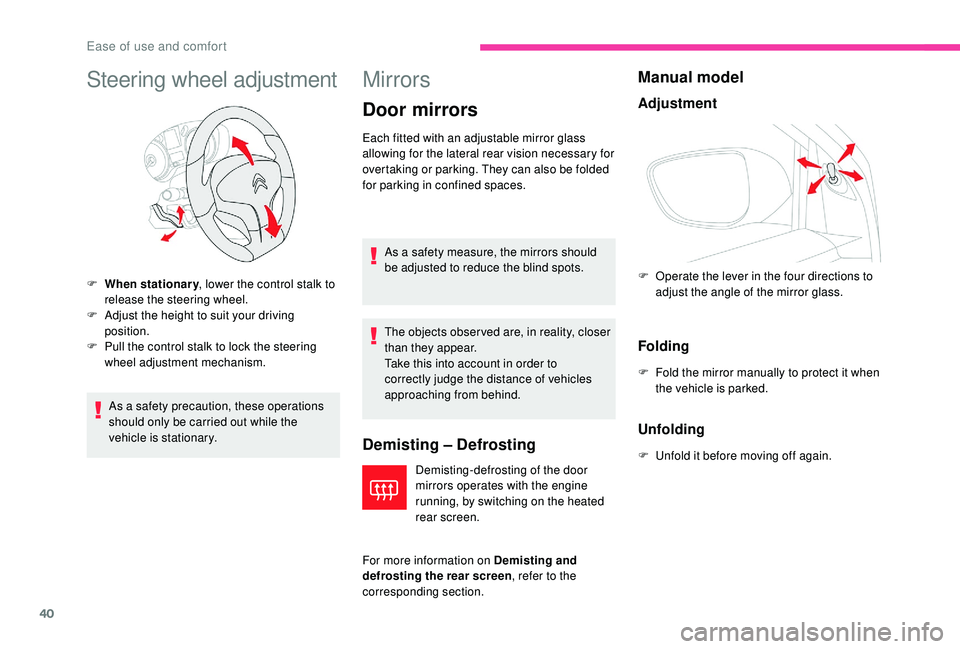
40
Steering wheel adjustment
As a safety precaution, these operations
should only be carried out while the
vehicle is stationary.
Mirrors
Door mirrors
Demisting – Defrosting
Demisting-defrosting of the door
mirrors operates with the engine
running, by switching on the heated
rear screen.
For more information on Demisting and
defrosting the rear screen , refer to the
corresponding section.
Manual model
Adjustment
Folding
F Fold the mirror manually to protect it when the vehicle is parked.
Unfolding
F Unfold it before moving off again.
F
W
hen stationary
, lower the control stalk to
release the steering wheel.
F
A
djust the height to suit your driving
position.
F
P
ull the control stalk to lock the steering
wheel adjustment mechanism. Each fitted with an adjustable mirror glass
allowing for the lateral rear vision necessary for
overtaking or parking. They can also be folded
for parking in confined spaces.
As a safety measure, the mirrors should
be adjusted to reduce the blind spots.
The objects obser ved are, in reality, closer
than they appear.
Take this into account in order to
correctly judge the distance of vehicles
approaching from behind. F
O
perate the lever in the four directions to
adjust the angle of the mirror glass.
Ease of use and comfort
Page 58 of 260
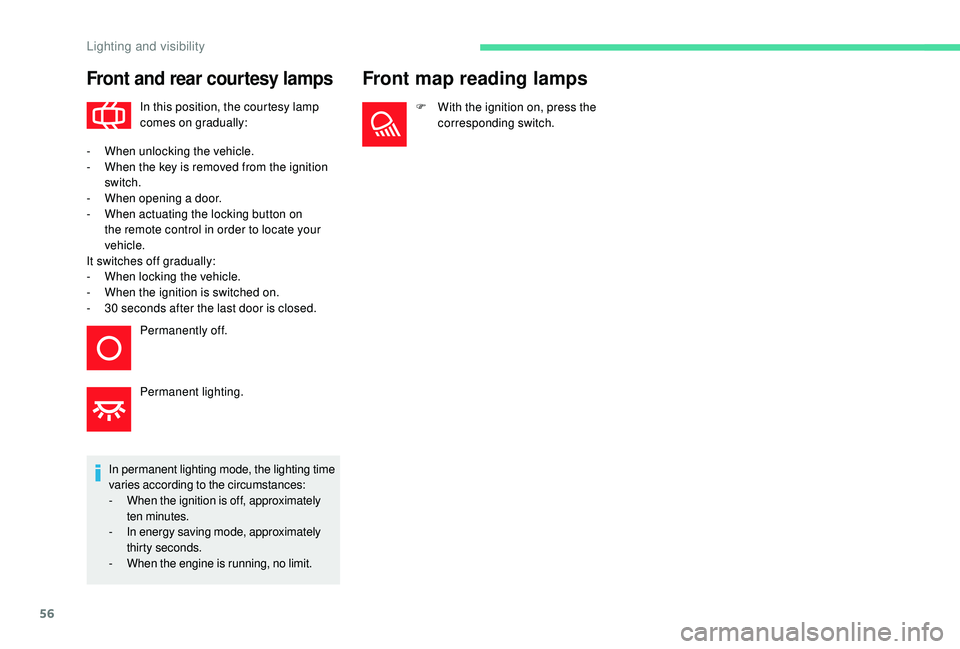
56
Front and rear courtesy lamps
In this position, the courtesy lamp
comes on gradually:
In permanent lighting mode, the lighting time
varies according to the circumstances:
-
W
hen the ignition is off, approximately
ten minutes.
-
I
n energy saving mode, approximately
thirty seconds.
-
W
hen the engine is running, no limit.
Front map reading lamps
F With the ignition on, press the corresponding switch.
-
W
hen unlocking the vehicle.
-
W
hen the key is removed from the ignition
switch.
-
W
hen opening a door.
-
W
hen actuating the locking button on
the remote control in order to locate your
vehicle.
It switches off gradually:
-
W
hen locking the vehicle.
-
W
hen the ignition is switched on.
-
3
0
seconds after the last door is closed. Permanently off.
Permanent lighting.
Lighting and visibility
Page 62 of 260

60
If you purchased your vehicle outside the
Brand network, we invite you to check
the configuration of these ser vices and,
if desired, have a dealer change it to suit
your wishes. In a multilingual country,
configuration is possible in the official
national language of your choice.
For technical reasons and, in particular,
to improve the quality of the "telematic
services" services for customers, the
manufacturer reser ves the right to carry
out updates to the vehicle's on-board
communication system.Electronic stability control
(ESC)
A set of the following Electronic Stability
systems:
-
a
nti-lock braking system (ABS) and
electronic brake force distribution (EBFD),
-
em
ergency braking assistance (EBA),
-
w
heel anti-slip regulation (ASR) or traction
control,
-
d
ynamic stability control (DSC).
Definitions
Anti-lock braking system (ABS)
and electronic brake force
distribution (EBFD)
These systems improve the stability and
manoeuvrability of your vehicle when braking
and contribute towards improved control in
corners, in particular on poor or slippery road
surfaces.
The ABS prevents wheel lock in the event of
emergency braking.
The electronic brake force distribution system
manages the braking pressure wheel by wheel.
Emergency braking assistance
(EBA)
In an emergency, this system enables you to
reach the optimum braking pressure more
quickly and therefore reduce the stopping
distance.
Anti-slip regulation (ASR)
This system optimises traction in order to
avoid wheel slip by acting on the brakes of
the driving wheels and on the engine. It also
improves the directional stability of the vehicle
on acceleration.
Dynamic stability control (DSC)
If there is a difference between the path
followed by the vehicle and that required by the
driver, this system monitors each wheel and
automatically acts on the brake of one or more
wheels and on the engine to return the vehicle
to the required path, within the limits of the laws
of physics. It is triggered in relation to the speed at which
the brake pedal is pressed. This is felt by a
reduction in the resistance of the pedal and an
increase in braking efficiency.
Safety
Page 63 of 260

61
Anti-lock braking system
(ABS) and electronic brake
force distribution (EBFD)
The fixed illumination of this warning
lamp signals that there is a fault with
the ABS.
Illumination of this warning lamp,
coupled with the STOP and ABS
warning lamps, accompanied by
the display of a message and an
audible signal, signals that there is a
fault with the electronic brake force
distribution (EBFD).
Normal operation of the ABS may make
itself felt by slight vibration of the brake
pedal.
When braking in an emergency, press
firmly without ever releasing the
pressure. When changing wheels (tyres and rims),
ensure that these are approved for your
vehicle.Anti-slip regulation (ASR)
/ Dynamic stability control
(DSC)
Operation
These systems are activated automatically
every time the vehicle is started.
They come into operation in the event of a
problem of grip or trajectory.
Deactivation
In exceptional conditions (starting a vehicle
which is bogged down, stuck in snow, on soft
ground, etc.), it may be advisable to deactivate
these systems, so that the wheels can turn
freely and regain grip.
Reactivate the systems as soon as the level of
grip permits.
The vehicle retains conventional braking. Drive
carefully at moderate speed.
Contact a CITROËN dealer or a qualified
workshop as soon as possible.
You must stop as soon as it is safe to do so.
Call a CITROËN dealer or a qualified
workshop. This is indicated by this warning
lamp flashing in the instrument
panel.F
P
ress this button until the
corresponding symbol appears
in the instrument panel.
The button indicator lamp comes on.
The ASR and DSC systems will no longer have
an effect on engine operation or the brakes in
the event of an involuntary change of trajectory.
Reactivation
The ASR system is reactivated automatically
every time the ignition is switched back on or
from 30
mph (50 km/h).
Below 30
mph (50 km/h), you can reactivate it
manually.
F
P
ress this button again to
reactivate the system manually.
The button indicator lamp goes off.
5
Safety
Page 66 of 260
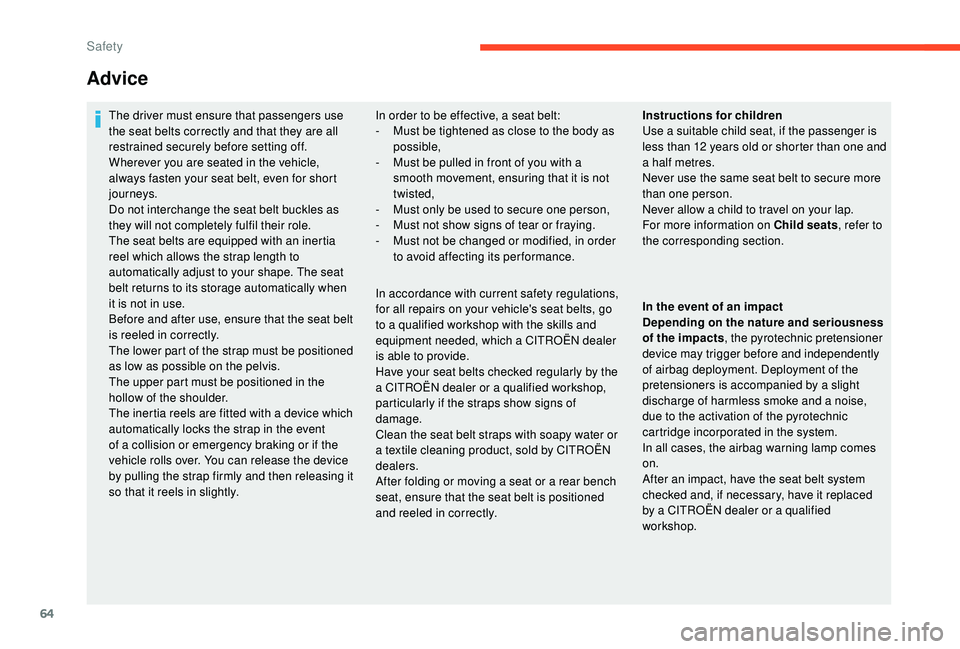
64
Advice
The driver must ensure that passengers use
the seat belts correctly and that they are all
restrained securely before setting off.
Wherever you are seated in the vehicle,
always fasten your seat belt, even for short
journeys.
Do not interchange the seat belt buckles as
they will not completely fulfil their role.
The seat belts are equipped with an inertia
reel which allows the strap length to
automatically adjust to your shape. The seat
belt returns to its storage automatically when
it is not in use.
Before and after use, ensure that the seat belt
is reeled in correctly.
The lower part of the strap must be positioned
as low as possible on the pelvis.
The upper part must be positioned in the
hollow of the shoulder.
The inertia reels are fitted with a device which
automatically locks the strap in the event
of a collision or emergency braking or if the
vehicle rolls over. You can release the device
by pulling the strap firmly and then releasing it
so that it reels in slightly.In order to be effective, a seat belt:
-
M ust be tightened as close to the body as
possible,
-
M
ust be pulled in front of you with a
smooth movement, ensuring that it is not
twisted,
-
M
ust only be used to secure one person,
-
M
ust not show signs of tear or fraying.
-
M
ust not be changed or modified, in order
to avoid affecting its performance. Instructions for children
Use a suitable child seat, if the passenger is
less than 12
years old or shorter than one and
a half metres.
Never use the same seat belt to secure more
than one person.
Never allow a child to travel on your lap.
For more information on Child seats , refer to
the corresponding section.
In accordance with current safety regulations,
for all repairs on your vehicle's seat belts, go
to a qualified workshop with the skills and
equipment needed, which a CITROËN dealer
is able to provide.
Have your seat belts checked regularly by the
a CITROËN dealer or a qualified workshop,
particularly if the straps show signs of
damage.
Clean the seat belt straps with soapy water or
a textile cleaning product, sold by CITROËN
dealers.
After folding or moving a seat or a rear bench
seat, ensure that the seat belt is positioned
and reeled in correctly. In the event of an impact
Depending on the nature and seriousness
of the impacts
, the pyrotechnic pretensioner
device may trigger before and independently
of airbag deployment. Deployment of the
pretensioners is accompanied by a slight
discharge of harmless smoke and a noise,
due to the activation of the pyrotechnic
cartridge incorporated in the system.
In all cases, the airbag warning lamp comes
on.
After an impact, have the seat belt system
checked and, if necessary, have it replaced
by a CITROËN dealer or a qualified
workshop.
Safety
Page 80 of 260

78
Advice
The incorrect installation of a child seat in a
vehicle compromises the child's protection in
the event of an accident.
Check that there is no seat belt or seat belt
buckle under the child seat as this could
make it unstable.
Remember to fasten the seat belts or the
child seat harnesses keeping the slack
relative to the child's body to a minimum,
even for short journeys.
When installing a child seat using the seat
belt, ensure that the seat belt is tightened
correctly on the child seat and that it secures
the child seat firmly on the seat of your
vehicle. If your passenger seat is adjustable,
move it for wards if necessary.
In the rear, always leave sufficient space
between the front seat and:
-
a "
rear ward facing" child seat,
-
t
he feet of a child seated in a "for ward
facing" child seat.
For this, move the seat for ward and, if
necessary, straighten its backrest too.
For optimal installation of the "forward facing"
child seat, ensure that its backrest is as close
as possible to the backrest of the vehicle
seat, if possible in contact with it. The head restraint must be removed before
installing a child seat with a backrest on a
passenger seat.
Ensure that the head restraint is stored or
attached securely to prevent it from being
thrown around the vehicle in the event of
sharp braking. Refit the head restraint once
the child seat has been removed.
CITROËN recommends using a booster seat
with a backrest, equipped with a belt guide at
shoulder level.
As a safety precaution, do not leave:
-
a c
hild or children alone and unattended in
a vehicle,
-
a c
hild or an animal in a vehicle exposed
to the sun, with the windows closed,
-
t
he keys within the reach of children inside
the vehicle.
To prevent accidental opening of the doors
and rear windows, use the child lock.
Take care not to open the rear windows by
more than one third.
To protect young children from the rays of the
sun, fit side blinds on the rear windows.
Children in the front
The legislation on carrying children on the
front passenger seat is specific to each
country. Refer to the legislation in force in
your country.
Deactivate the passenger's front airbag when
a "rear ward facing" child seat is installed on
the front passenger seat.
Otherwise, the child risks being seriously
injured or killed if the airbag is deployed.
Installing a booster seat
The chest part of the seat belt must be
positioned on the child's shoulder without
touching the neck.
Ensure that the lap part of the seat belt
passes correctly over the child's thighs.
Safety
Page 81 of 260

79
Manual child lock
Mechanical system to prevent opening of a rear
door using its interior control.
Locking
Unlocking
F With the ignition key, turn the red control one quarter of a turn:
-
T
o the left on the left-hand rear door.
-
T
o the right on the right-hand rear door.
The control is located on the edge of each rear
d o o r.
F
W
ith the ignition key, turn the red control
one quarter of a turn:
-
T
o the right on the left-hand rear door.
-
T
o the left on the right-hand rear door.
5
Safety